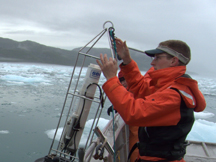CIFAR
Cooperative Institute for Alaska ResearchNew paper: Does calving matter? Evidence for significant submarine melt
November 20, 2013

Tim Bartholomaus. Photo by Nathan Rice.
For many glaciers that flow into the sea, including some in southern Alaska and most of the Greenland and Antarctic ice sheets, the loss of ice to the ocean can dwarf that which is lost to melt beneath the sun’s rays or warm skies. But the exact fate of the ice that reaches the sea is uncertain, and the relative importance of icebergs breaking off the terminus in a process called calving, compared to ice melting in contact with warm ocean water, is unknown at nearly all glaciers. Several recent studies, including some in Alaska, have shown that submarine melt rates can equal, and sometimes exceed, calving rates, but few studies have examined mass loss at glacier termini, and the geographic extent over which rapid submarine melt occurs is not yet clear.
The question of mass loss was addressed by Tim Bartholomaus, a Ph.D. student at the University of Alaska Fairbanks, and colleagues in a recent paper (October 2013) in Earth and Planetary Science Letters. Tim’s work was partially supported by a UAF Global Change Research Grant awarded in 2010 with funding from CIFAR.
In order to quantify the importance of submarine melt at Yahtse Glacier, which terminates in Icy Bay on the Gulf of Alaska, Tim and co-authors Chris Larsen and Shad O’Neel, along with several collaborators, measured the temperature and salinity of seawater throughout Icy Bay. They found cold, fresh, glacially modified water, containing between 0.5 and 2.8% glacier ice melt, overlays warmer water from the Gulf of Alaska that reaches temperatures in excess of 10 °C. By estimating the current within the glacially modified water, they determined that warm ocean water could easily melt submarine ice at 17 m/d, the rate the glacier flows down towards the terminus. This suggests ice loss at the glacier terminus may be paced by the rate of submarine melt and that iceberg calving above sea level is likely controlled by the rate at which the foundations of would-be icebergs melt out from below them. The authors conclude that efforts to understand and predict rates of mass loss from ocean-terminating glaciers are unlikely to be successful unless submarine melt is explicitly accounted for.
A profile of Tim Bartholomaus can be found on the UAF Center for Global Change website. Check out Tim's web page to learn more about his research.

